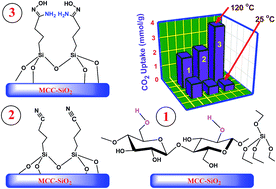Amidoxime-functionalized microcrystalline cellulose–mesoporous silica composites for carbon dioxide sorption at elevated temperatures†
Abstract
Amidoxime-functionalized microcrystalline cellulose (MCC)–mesoporous silica composites were prepared for the first time by a two-step process. First, microcrystalline cellulose (MCC)–mesoporous silica with cyanopropyl groups (MCC-CP) was obtained by solvent evaporation-induced self-assembly of MCC, tetraethylorthosilicate, and (3-cyanopropyl)triethoxysilane in the presence of a Pluronic P123 triblock copolymer under acidic conditions. In the next step, the resulting material was treated with hydroxylamine hydrochloride to convert cyanopropyl groups into amidoxime functionalities to obtain a mesoporous MCC-AO composite. A series of MCC-CP and MCC-AO samples was examined for CO2 sorption at ambient (25 °C) and elevated (120 °C) temperatures. While the MCC-CP and MCC-AO samples showed relatively low CO2 uptake under ambient conditions, they performed very well at elevated temperatures (120 °C) reaching CO2 sorption capacities of 2.15–2.41 mmol g−1 (MCC-CP) and 2.84–3.85 mmol g−1 (MCC-AO). The CO2 sorption capacity of MCC-AO at 120 °C exceeds the values reported so far for many other sorbents, which makes this material attractive for CO2 capture in addition to its biocompatibility, biodegradability, non-toxicity, low cost, cycle stability, and good thermal and mechanical stability.


 Please wait while we load your content...
Please wait while we load your content...